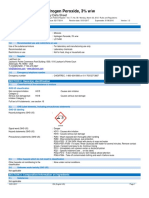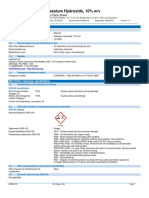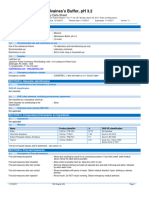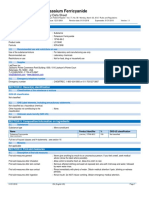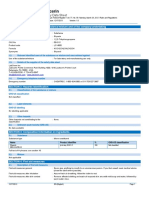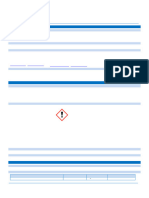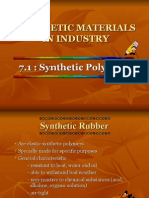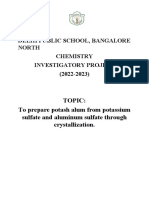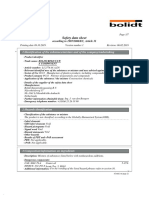LC 25940
LC 25940
Uploaded by
Putri AlyaCopyright:
Available Formats
LC 25940
LC 25940
Uploaded by
Putri AlyaOriginal Title
Copyright
Available Formats
Share this document
Did you find this document useful?
Is this content inappropriate?
Copyright:
Available Formats
LC 25940
LC 25940
Uploaded by
Putri AlyaCopyright:
Available Formats
Tartaric Acid
Safety Data Sheet
according to Federal Register / Vol. 77, No. 58 / Monday, March 26, 2012 / Rules and Regulations
Date of issue: 02/10/2015 Revision date: 05/15/2018 Supersedes: 05/15/2018 Version: 1.1
SECTION 1: Identification
1.1. Identification
Product form : Substance
Substance name : Tartaric Acid
Chemical name : 2,3-Dihydroxybutanedioic acid
CAS-No. : 87-69-4
Product code : LC25940
Formula : HOOC(CHOH)2COOH
Other means of identification : L-tartaric acid
1.2. Recommended use and restrictions on use
Use of the substance/mixture : For laboratory and manufacturing use only.
Recommended use : Laboratory chemicals
Restrictions on use : Not for food, drug or household use
1.3. Supplier
LabChem Inc
Jackson's Pointe Commerce Park Building 1000, 1010 Jackson's Pointe Court
Zelienople, PA 16063 - USA
T 412-826-5230 - F 724-473-0647
info@labchem.com - www.labchem.com
1.4. Emergency telephone number
Emergency number : CHEMTREC: 1-800-424-9300 or +1-703-741-5970
SECTION 2: Hazard(s) identification
2.1. Classification of the substance or mixture
GHS-US classification
Serious eye damage/eye H318 Causes serious eye damage
irritation Category 1
Hazardous to the aquatic H402 Harmful to aquatic life
environment - Acute
Hazard Category 3
Full text of H statements : see section 16
2.2. GHS Label elements, including precautionary statements
GHS-US labeling
Hazard pictograms (GHS-US) :
GHS05
Signal word (GHS-US) : Danger
Hazard statements (GHS-US) : H318 - Causes serious eye damage
H402 - Harmful to aquatic life
Precautionary statements (GHS-US) : P273 - Avoid release to the environment.
P280 - Wear eye protection.
P305+P351+P338 - If in eyes: Rinse cautiously with water for several minutes. Remove contact
lenses, if present and easy to do. Continue rinsing
P310 - Immediately call a poison center or doctor/physician.
P501 - Dispose of contents/container to comply with local, state and federal regulations
2.3. Other hazards which do not result in classification
Other hazards not contributing to the : None under normal conditions.
classification
2.4. Unknown acute toxicity (GHS US)
Not applicable
05/15/2018 EN (English US) Page 1
Tartaric Acid
Safety Data Sheet
according to Federal Register / Vol. 77, No. 58 / Monday, March 26, 2012 / Rules and Regulations
SECTION 3: Composition/Information on ingredients
3.1. Substances
Substance type : Mono-constituent
Name Product identifier % GHS-US classification
Tartaric Acid (CAS-No.) 87-69-4 100 Eye Dam. 1, H318
(Main constituent) Aquatic Acute 3, H402
Full text of hazard classes and H-statements : see section 16
3.2. Mixtures
Not applicable
SECTION 4: First-aid measures
4.1. Description of first aid measures
First-aid measures general : Never give anything by mouth to an unconscious person. If you feel unwell, seek medical
advice (show the label where possible).
First-aid measures after inhalation : Allow victim to breathe fresh air. Allow the victim to rest.
First-aid measures after skin contact : Remove affected clothing and wash all exposed skin area with mild soap and water, followed
by warm water rinse.
First-aid measures after eye contact : Rinse cautiously with water for several minutes. Remove contact lenses, if present and easy to
do. Continue rinsing. Immediately call a poison center or doctor/physician.
First-aid measures after ingestion : Rinse mouth. Do NOT induce vomiting. Obtain emergency medical attention.
4.2. Most important symptoms and effects (acute and delayed)
Symptoms/effects after eye contact : Causes serious eye damage.
4.3. Immediate medical attention and special treatment, if necessary
Obtain medical assistance.
SECTION 5: Fire-fighting measures
5.1. Suitable (and unsuitable) extinguishing media
Suitable extinguishing media : Foam. Dry powder. Carbon dioxide. Water spray. Sand.
Unsuitable extinguishing media : Do not use a heavy water stream.
5.2. Specific hazards arising from the chemical
No additional information available
5.3. Special protective equipment and precautions for fire-fighters
Firefighting instructions : Use water spray or fog for cooling exposed containers. Exercise caution when fighting any
chemical fire. Prevent fire-fighting water from entering environment.
Protection during firefighting : Do not enter fire area without proper protective equipment, including respiratory protection.
SECTION 6: Accidental release measures
6.1. Personal precautions, protective equipment and emergency procedures
6.1.1. For non-emergency personnel
Protective equipment : Safety glasses.
Emergency procedures : Evacuate unnecessary personnel.
6.1.2. For emergency responders
Protective equipment : Equip cleanup crew with proper protection.
Emergency procedures : Ventilate area.
6.2. Environmental precautions
Prevent entry to sewers and public waters. Notify authorities if liquid enters sewers or public waters. Avoid release to the environment.
6.3. Methods and material for containment and cleaning up
Methods for cleaning up : On land, sweep or shovel into suitable containers. Minimize generation of dust. Store away
from other materials.
6.4. Reference to other sections
See Heading 8. Exposure controls and personal protection.
05/15/2018 EN (English US) 2/6
Tartaric Acid
Safety Data Sheet
according to Federal Register / Vol. 77, No. 58 / Monday, March 26, 2012 / Rules and Regulations
SECTION 7: Handling and storage
7.1. Precautions for safe handling
Precautions for safe handling : Wash hands and other exposed areas with mild soap and water before eating, drinking or
smoking and when leaving work. Provide good ventilation in process area to prevent formation
of vapor.
Hygiene measures : Wash exposed skin thoroughly after handling.
7.2. Conditions for safe storage, including any incompatibilities
Storage conditions : Keep container closed when not in use.
Incompatible products : Strong bases. Strong oxidizers.
Incompatible materials : Sources of ignition. Direct sunlight.
SECTION 8: Exposure controls/personal protection
8.1. Control parameters
No additional information available
8.2. Appropriate engineering controls
Appropriate engineering controls : Emergency eye wash fountains should be available in the immediate vicinity of any potential
exposure.
8.3. Individual protection measures/Personal protective equipment
Personal protective equipment:
Gloves. Safety glasses.
Hand protection:
Wear protective gloves.
Eye protection:
Chemical goggles or safety glasses
Respiratory protection:
Respiratory protection not required in normal
conditions
Other information:
Do not eat, drink or smoke during use.
SECTION 9: Physical and chemical properties
9.1. Information on basic physical and chemical properties
Physical state : Solid
Color : White
Odor : None.
Odor threshold : No data available
pH : No data available
pH solution : 150 (1 - 2) g/l
Melting point : 168 - 172 °C
Freezing point : No data available
Boiling point : No data available
Flash point : 150 °C
Relative evaporation rate (butyl acetate=1) : No data available
Flammability (solid, gas) : Non flammable.
05/15/2018 EN (English US) 3/6
Tartaric Acid
Safety Data Sheet
according to Federal Register / Vol. 77, No. 58 / Monday, March 26, 2012 / Rules and Regulations
Vapor pressure : No data available
Relative vapor density at 20 °C : 5.18 Air = 1
Relative density : 1.76 Water = 1
Molecular mass : 150.09 g/mol
Solubility : Soluble in water. Soluble in methanol. Soluble in ether. Soluble in ethanol. Soluble in glycerol.
Water: 139 g/100ml
Log Pow : -1.909
Auto-ignition temperature : 425 °C
Decomposition temperature : No data available
Viscosity, kinematic : No data available
Viscosity, dynamic : No data available
Explosion limits : No data available
Explosive properties : No data available
Oxidizing properties : No data available
9.2. Other information
No additional information available
SECTION 10: Stability and reactivity
10.1. Reactivity
No additional information available
10.2. Chemical stability
Stable under normal conditions.
10.3. Possibility of hazardous reactions
Not established.
10.4. Conditions to avoid
Direct sunlight. Extremely high or low temperatures.
10.5. Incompatible materials
Strong oxidizers. Strong bases.
10.6. Hazardous decomposition products
Carbon monoxide. Carbon dioxide.
SECTION 11: Toxicological information
11.1. Information on toxicological effects
Likely routes of exposure : Inhalation; Skin and eye contact; Ingestion
Acute toxicity : Not classified
Tartaric Acid (87-69-4)
LD50 oral rat > 2000 mg/kg
LD50 dermal rat > 2000 mg/kg
Additional information Lowest Published Lethal DoseLDLo, oral, rat: 7500 mg/kg
Skin corrosion/irritation : Not classified
Serious eye damage/irritation : Causes serious eye damage.
Respiratory or skin sensitization : Not classified
Germ cell mutagenicity : Not classified
Carcinogenicity : Not classified
Reproductive toxicity : Not classified
Specific target organ toxicity – single exposure : Not classified
Specific target organ toxicity – repeated : Not classified
exposure
Aspiration hazard : Not classified
05/15/2018 EN (English US) 4/6
Tartaric Acid
Safety Data Sheet
according to Federal Register / Vol. 77, No. 58 / Monday, March 26, 2012 / Rules and Regulations
Potential Adverse human health effects and : Based on available data, the classification criteria are not met.
symptoms
Symptoms/effects after eye contact : Causes serious eye damage.
SECTION 12: Ecological information
12.1. Toxicity
Ecology - water : Harmful to aquatic life.
Tartaric Acid (87-69-4)
EC50 Daphnia 1 93.31 mg/l 48 hr.
EC50 other aquatic organisms 1 51.4 mg/l 72 hr.
12.2. Persistence and degradability
Tartaric Acid (87-69-4)
Persistence and degradability Readily biodegradable in water.
12.3. Bioaccumulative potential
Tartaric Acid (87-69-4)
Log Pow -1.909
Bioaccumulative potential Low potential for bioaccumulation (Log Kow < 4).
12.4. Mobility in soil
No additional information available
12.5. Other adverse effects
Other information : Avoid release to the environment.
SECTION 13: Disposal considerations
13.1. Disposal methods
Waste disposal recommendations : Dispose in a safe manner in accordance with local/national regulations. Dispose of
contents/container to comply with local, state and federal regulations.
Ecology - waste materials : Avoid release to the environment.
SECTION 14: Transport information
Department of Transportation (DOT)
In accordance with DOT
Not regulated
SECTION 15: Regulatory information
15.1. US Federal regulations
Tartaric Acid (87-69-4)
Listed on the United States TSCA (Toxic Substances Control Act) inventory
SARA Section 311/312 Hazard Classes Immediate (acute) health hazard
All components of this product are listed, or excluded from listing, on the United States Environmental Protection Agency Toxic
Substances Control Act (TSCA) inventory
15.2. International regulations
CANADA
Tartaric Acid (87-69-4)
Listed on the Canadian DSL (Domestic Substances List)
EU-Regulations
No additional information available
National regulations
05/15/2018 EN (English US) 5/6
Tartaric Acid
Safety Data Sheet
according to Federal Register / Vol. 77, No. 58 / Monday, March 26, 2012 / Rules and Regulations
Tartaric Acid (87-69-4)
Not listed on the Canadian IDL (Ingredient Disclosure List)
15.3. US State regulations
California Proposition 65 - This product does not contain any substances known to the state of California to cause cancer,
developmental and/or reproductive harm
SECTION 16: Other information
Revision date : 05/15/2018
Other information : None.
Full text of H-phrases: see section 16:
--- H318 Causes serious eye damage
---
--- H402 Harmful to aquatic life
---
NFPA health hazard : 2 - Materials that, under emergency conditions, can cause
temporary incapacitation or residual injury.
NFPA fire hazard : 0 - Materials that will not burn under typical fire conditions,
including intrinsically noncombustible materials such as
concrete, stone, and sand.
NFPA reactivity : 0 - Material that in themselves are normally stable, even
under fire conditions.
Hazard Rating
Health : 2 Moderate Hazard - Temporary or minor injury may occur
Flammability : 0 Minimal Hazard - Materials that will not burn
Physical : 0 Minimal Hazard - Materials that are normally stable, even under fire conditions, and will NOT
react with water, polymerize, decompose, condense, or self-react. Non-Explosives.
Personal protection : A
A - Safety glasses
SDS US LabChem
Information in this SDS is from available published sources and is believed to be accurate. No warranty, express or implied, is made and LabChem Inc assumes no liability resulting from the use of this
SDS. The user must determine suitability of this information for his application.
05/15/2018 EN (English US) 6/6
You might also like
- Coiled Tubing HandbookDocument333 pagesCoiled Tubing Handbookdaniel80% (10)
- SDS of Tartaric AcidDocument6 pagesSDS of Tartaric AcidWici WiciNo ratings yet
- Sodium Tetraborate, Decahydrate: Safety Data SheetDocument6 pagesSodium Tetraborate, Decahydrate: Safety Data SheetAnnisa MardhatillahNo ratings yet
- KKT Protect - KKT PROTECT INHIBITED EG 37 MSDSDocument7 pagesKKT Protect - KKT PROTECT INHIBITED EG 37 MSDSEduardo JoseNo ratings yet
- Buffer Solution PH 10.00: Safety Data SheetDocument7 pagesBuffer Solution PH 10.00: Safety Data SheetMay BernardoNo ratings yet
- Buffer Solution PH 10.00: Safety Data SheetDocument7 pagesBuffer Solution PH 10.00: Safety Data SheetMay BernardoNo ratings yet
- Potassium Hydrogen Phthalate: Safety Data SheetDocument6 pagesPotassium Hydrogen Phthalate: Safety Data SheetdeleonmatthewreiNo ratings yet
- Bakhitah Nurul - H031211007 (TP KimDas 3)Document14 pagesBakhitah Nurul - H031211007 (TP KimDas 3)Bakhitah NurulNo ratings yet
- LC24774Document6 pagesLC24774Muhammad Khalid KhaeruddinNo ratings yet
- Sodium Bicarbonate PDFDocument6 pagesSodium Bicarbonate PDFbastiNo ratings yet
- Sodium Bicarbonate: Safety Data SheetDocument6 pagesSodium Bicarbonate: Safety Data Sheetayakashi hanatoNo ratings yet
- SDS Citric AcidDocument6 pagesSDS Citric AcidZeeshan KhanNo ratings yet
- Msds h202Document7 pagesMsds h202permatayaNo ratings yet
- MSDS Na K TartratDocument6 pagesMSDS Na K TartratRaihana RizkaNo ratings yet
- Calcium Chloride, Dihydrate: Safety Data SheetDocument6 pagesCalcium Chloride, Dihydrate: Safety Data SheetMuhammad AfifNo ratings yet
- LC15440Document7 pagesLC15440Sruthi SomanNo ratings yet
- Msds Na2S2O3.5H2ODocument6 pagesMsds Na2S2O3.5H2OLuthfi Prananta WibawaNo ratings yet
- Potassium Iodide: Safety Data SheetDocument6 pagesPotassium Iodide: Safety Data SheetRumNo ratings yet
- LC13410 Copper SulfateDocument6 pagesLC13410 Copper SulfateΒΑΓΓΕΛΗΣ ΑΝΤΩΝΙΟΥNo ratings yet
- Citric Acid, Anhydrous: Safety Data SheetDocument6 pagesCitric Acid, Anhydrous: Safety Data SheetPressesjg EllisNo ratings yet
- Potassium Hydroxide, 10% W/V: Safety Data SheetDocument7 pagesPotassium Hydroxide, 10% W/V: Safety Data SheetSreejith R MenonNo ratings yet
- LC16300 - McIlvaine's BufferDocument7 pagesLC16300 - McIlvaine's BufferZon JC ChouNo ratings yet
- Acetic Acid, 1.0N (1.0M) : Safety Data SheetDocument7 pagesAcetic Acid, 1.0N (1.0M) : Safety Data Sheetrama riouNo ratings yet
- Methyl Violet, 0.02% Aqueous: Safety Data SheetDocument6 pagesMethyl Violet, 0.02% Aqueous: Safety Data Sheetmaha muhammedNo ratings yet
- Potassium Ferricyanide: Safety Data SheetDocument6 pagesPotassium Ferricyanide: Safety Data SheetYulia Rahmayani RidwanNo ratings yet
- Eosin Y: Safety Data SheetDocument6 pagesEosin Y: Safety Data SheetFISR FAPSRNo ratings yet
- Sulfuric Acid, 4.0N (2.0M) : Safety Data SheetDocument8 pagesSulfuric Acid, 4.0N (2.0M) : Safety Data Sheetayakashi hanatoNo ratings yet
- Sodium Phosphate Solution, Saturated: Safety Data SheetDocument6 pagesSodium Phosphate Solution, Saturated: Safety Data Sheetxyz7890No ratings yet
- Glycerin: Safety Data SheetDocument6 pagesGlycerin: Safety Data SheetAnnisaNo ratings yet
- LC10030Document7 pagesLC10030joh SaragihNo ratings yet
- MSDS - Phytic Acid (Labchem)Document5 pagesMSDS - Phytic Acid (Labchem)NgocNo ratings yet
- Ammonium Sulfate: Safety Data SheetDocument6 pagesAmmonium Sulfate: Safety Data SheetAdilla Linaa Putri AmutyaNo ratings yet
- 4 - (Methylamino) Phenol SulphateDocument7 pages4 - (Methylamino) Phenol SulphateIqraNo ratings yet
- Lead Acetate, 10% W/V: Safety Data SheetDocument7 pagesLead Acetate, 10% W/V: Safety Data SheetYulia Rahmayani RidwanNo ratings yet
- Sodium Hypochlorite, 5% W/V: Safety Data SheetDocument7 pagesSodium Hypochlorite, 5% W/V: Safety Data Sheetmaha muhammedNo ratings yet
- Sodium Carbonate, Anhydrous: Safety Data SheetDocument6 pagesSodium Carbonate, Anhydrous: Safety Data SheetAlan ConnorNo ratings yet
- Washing Liquid - URS-100 Primary Liquid) MSDS PDFDocument7 pagesWashing Liquid - URS-100 Primary Liquid) MSDS PDFdanang setiawanNo ratings yet
- Methylene Blue, 1% Aqueous: Safety Data SheetDocument6 pagesMethylene Blue, 1% Aqueous: Safety Data Sheetmaha muhammedNo ratings yet
- Sodium Carbonate, Anhydrous: Safety Data SheetDocument6 pagesSodium Carbonate, Anhydrous: Safety Data SheetKiki ShofiaNo ratings yet
- Sodium Nitroprusside: Safety Data SheetDocument7 pagesSodium Nitroprusside: Safety Data SheetDwi NandaNo ratings yet
- Acetate Buffer PH 4.5, For Cyanide: Safety Data SheetDocument7 pagesAcetate Buffer PH 4.5, For Cyanide: Safety Data Sheetminyoon sugarNo ratings yet
- Potassium Thiocyanate, 0.1N (0.1M) : Safety Data SheetDocument6 pagesPotassium Thiocyanate, 0.1N (0.1M) : Safety Data SheetMohiuddin NaeemNo ratings yet
- LC11640Document7 pagesLC11640Rafly AnantaNo ratings yet
- Fire Stop Final Inss2460 Inss2460 Us en Sds 180808Document7 pagesFire Stop Final Inss2460 Inss2460 Us en Sds 180808Jamile Santos AraujoNo ratings yet
- Hydrochloric Acid, 0.1N (0.1M) : Safety Data SheetDocument6 pagesHydrochloric Acid, 0.1N (0.1M) : Safety Data SheetRobyRheinNo ratings yet
- Msds MurexidDocument5 pagesMsds MurexidGanjar Tri Gita AzhariNo ratings yet
- Sodium Chloride: Safety Data SheetDocument6 pagesSodium Chloride: Safety Data SheetMuhammad AfifNo ratings yet
- Sharomix 824 SDSDocument6 pagesSharomix 824 SDSnomadicaNo ratings yet
- Asam Sulfat 2N PDFDocument8 pagesAsam Sulfat 2N PDFWahyu TriNo ratings yet
- Magnesium Chloride, Hexahydrate: Safety Data SheetDocument5 pagesMagnesium Chloride, Hexahydrate: Safety Data Sheetphandang_tNo ratings yet
- CFS-CT CP 670 CP 673 CP 676: Safety Data SheetDocument8 pagesCFS-CT CP 670 CP 673 CP 676: Safety Data SheetforotherNo ratings yet
- Citric Acid, 10% W/V: Safety Data SheetDocument6 pagesCitric Acid, 10% W/V: Safety Data SheetCarreño AlejandroNo ratings yet
- Safety Data Sheet: SECTION 1: Identification of The Substance/mixture and of The Company/undertakingDocument6 pagesSafety Data Sheet: SECTION 1: Identification of The Substance/mixture and of The Company/undertakingdkjksdhfusdNo ratings yet
- EHDiolDocument6 pagesEHDiolfabrizzio molina perezNo ratings yet
- MCF UsDocument7 pagesMCF UsloukismakrisNo ratings yet
- Fuchs Titan Race Pro S 5w 40Document10 pagesFuchs Titan Race Pro S 5w 40Yasin YañezNo ratings yet
- GreenClean Alkaline Cleaner EnglishSDS 7300 CANDocument11 pagesGreenClean Alkaline Cleaner EnglishSDS 7300 CANNawwarNo ratings yet
- Hydrochloric Acid, 0.1N (0.1M) : Safety Data SheetDocument10 pagesHydrochloric Acid, 0.1N (0.1M) : Safety Data SheetSuperZero 'SpZ'No ratings yet
- Rescobond Aa 22s MsdsDocument7 pagesRescobond Aa 22s MsdsDilip PatilNo ratings yet
- Msds 1Document7 pagesMsds 1Bonner NuwagabaNo ratings yet
- Guidelines for Personal Protection When Handling and Applying Pesticides: International Code of Conduct on Pesticide ManagementFrom EverandGuidelines for Personal Protection When Handling and Applying Pesticides: International Code of Conduct on Pesticide ManagementNo ratings yet
- 2 Sarnatape-200 PDS GCC (04-2015) 1Document3 pages2 Sarnatape-200 PDS GCC (04-2015) 1Savu CristianNo ratings yet
- Scaffold in Tissue EngDocument13 pagesScaffold in Tissue EngOluwasegun ModupeNo ratings yet
- Mechanics-2 2 Axial LoadingDocument22 pagesMechanics-2 2 Axial LoadingMuhd NizammudinNo ratings yet
- 2-1 2-2 AsepticProcessingDocument47 pages2-1 2-2 AsepticProcessingChristopher Sexton100% (1)
- USP-NF Guia 621 - CromatografiaDocument9 pagesUSP-NF Guia 621 - CromatografiaSoraya OchsNo ratings yet
- 3 PDFDocument199 pages3 PDFsanku surya sai charanNo ratings yet
- Chemistry Project OnDocument23 pagesChemistry Project OnGauravNo ratings yet
- Science Form 5 Synthetic Materials in IndustryDocument10 pagesScience Form 5 Synthetic Materials in Industrydebbycley100% (11)
- Slides Chapter 5 Ceramic MaterialsDocument80 pagesSlides Chapter 5 Ceramic MaterialsSreekumar RajendrababuNo ratings yet
- Chemistry Investigatory ProjectDocument16 pagesChemistry Investigatory ProjectS JAY ADHITYAANo ratings yet
- Handout BCDocument16 pagesHandout BCNabesanNo ratings yet
- Lab Assignment of PackagingDocument5 pagesLab Assignment of PackagingZarakhankhan KhanNo ratings yet
- Corrosion Prevention and Appearance Care: Protecting Your Toyota From CorrosionDocument6 pagesCorrosion Prevention and Appearance Care: Protecting Your Toyota From Corrosionmemogomez00No ratings yet
- 9701 Y25-27 Sy-PagesDocument4 pages9701 Y25-27 Sy-PagesanjuNo ratings yet
- PHD Thesis Supramolecular ChemistryDocument4 pagesPHD Thesis Supramolecular Chemistrygxgtpggld100% (2)
- Nozzle Thrust and Efficiency MeasurementDocument12 pagesNozzle Thrust and Efficiency MeasurementDhruvNagpalNo ratings yet
- Anthracite: 2 PropertiesDocument8 pagesAnthracite: 2 PropertiesHasim BenziniNo ratings yet
- Chemistry AQA Chemistry Physical 1 AnswersDocument31 pagesChemistry AQA Chemistry Physical 1 AnswersEmma FordNo ratings yet
- Abate SDSDocument9 pagesAbate SDSazreen96.worksNo ratings yet
- Pis Taski Spiral HDDocument2 pagesPis Taski Spiral HDMaddyNo ratings yet
- Experimental Study of Cuttings Transport in Directional WellsDocument14 pagesExperimental Study of Cuttings Transport in Directional WellsFabian Andrey DiazNo ratings yet
- Safety Data Sheet: 1 Identification of The Substance/mixture and of The Company/undertakingDocument7 pagesSafety Data Sheet: 1 Identification of The Substance/mixture and of The Company/undertakingBradyNo ratings yet
- Biology Unit # 1 Module 1 - Cell and Molecular BiologyDocument15 pagesBiology Unit # 1 Module 1 - Cell and Molecular BiologyLton LuisNo ratings yet
- Nurul Aina HakimaDocument23 pagesNurul Aina HakimaAdam AdemNo ratings yet
- Training Material 126 Company Guidance For Recording Operations in The Oil Record Book PDFDocument37 pagesTraining Material 126 Company Guidance For Recording Operations in The Oil Record Book PDFkurupath100% (1)
- Chemistry Paper 3 SLDocument28 pagesChemistry Paper 3 SLsilagulec9No ratings yet
- Physics ProjectDocument10 pagesPhysics Projectrjjain07100% (1)
- Structural Bolts CatalogueDocument3 pagesStructural Bolts CatalogueTom CaineNo ratings yet
- Ionic Equilibrium-Study MaterialDocument32 pagesIonic Equilibrium-Study MaterialAhmed ShaalanNo ratings yet












